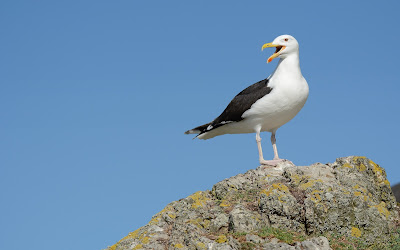An important part of our work in Dublin Bay involves the
ringing of key waterbird species to learn more about the birds and how they use
Dublin Bay. As well as providing us with important information on their usage
of breeding/feeding/roosting areas within the bay, we also get some very
interesting ring resightings of ‘our’ birds from further afield – some of the Terns
we’ve ringed in Dublin Bay have been resighted in Scotland, Wales, Northern
Ireland and on migration in Namibia!
 |
| Common Tern - the most numerous Tern in Dublin Bay. (BB) |
For the terns, these resightings are largely in line with
what we’d expect – we’d expect the terns that breed in Dublin would be using
parts of the Irish coast on migration and eventually end up in Namibia. We’d
also expect that the majority of the Terns that roost in Dublin Bay after the breeding season
might be from different parts of Ireland, or colonies nearby in the UK. Though
somewhat expected, this is still all very useful information to collect from a
conservation point of view! That being said, we do enjoy some of the more ‘novel’
and unusual sightings – so imagine our delight when we got an email from Oddvar
Olsen in Norway!
Enclosed in the email was the picture below of yellow ring
PUL – a ring we had put on an adult Common Tern at Sandymount Strand in south
Dublin last August. Sandymount gets several thousand terns in August and
September each year, roosting in the evenings for the few weeks between leaving
their breeding site and setting off on migration for African waters for the
winter (it's quite the sight on a late summer's evening!).
 |
| Colour-ring PUL - put on a Common Tern at Sandymount Strand last Autumn. |
 |
| PUL was caught in Dublin last Autumn, but won't be back this year! Ring found at Raudholmane in Norway this year. |
Now it’s always great when someone accompanies a resighting with a picture, so we can be absolutely 100% sure that the ring was read correctly etc. That being said it’s less great when there’s no bird in the picture…
 |
| Great Black-backed Gull - the largest gull in the world (BB) |
 |
| Great Black-backed Gull. (BB) |
In the coming weeks our Dublin Bay Birds Project staff and
I-WeBS team, along with some very dedicated volunteers, will be counting and
recording roosting Tern flocks around the country. We'd very much appreciate records/counts of tern flocks from around the country - full details here:
For anyone who thinks they might have spotted one of our Dublin-ringed Terns, please enter the details of the sighting here and we'll get back to you: https://bwi.maps.arcgis.com/apps/GeoForm/index.html?appid=6abe0ae78f9b4879937d2c1447537c46
Keep an eye out for the next blog later in the month!
- Brian B
No comments:
Post a Comment